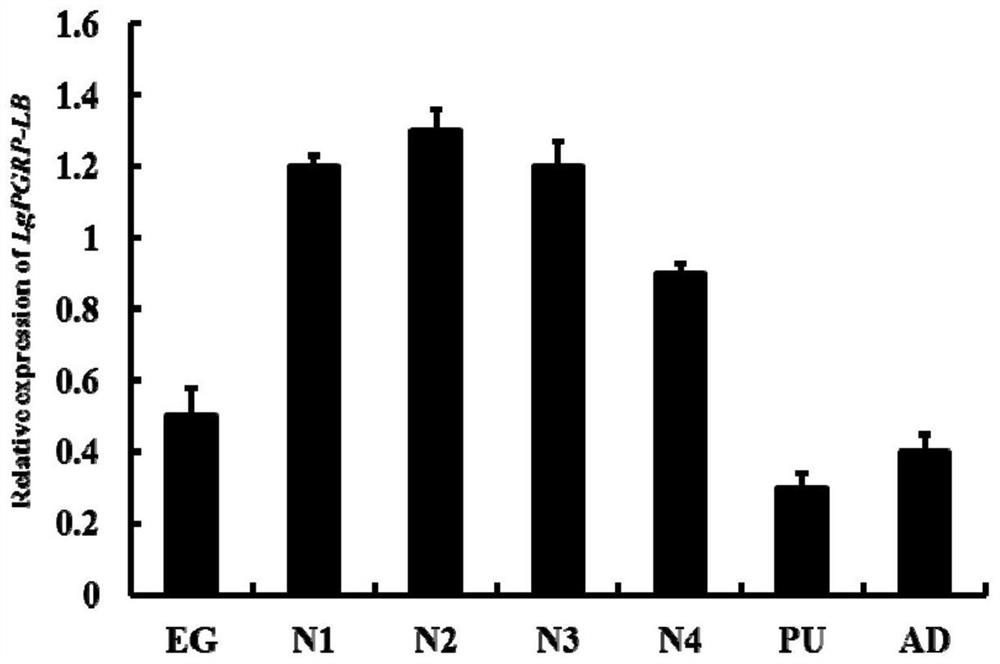Soybean borer lgpgrp-lb gene and its application
A soybean carnivorous insect and anti-eating insect technology can be used in application, genetic engineering, plant genetic improvement, etc., and can solve the problems of polluted environment, low efficiency, and increased drug resistance of soybean carnivorous insects.
- Summary
- Abstract
- Description
- Claims
- Application Information
AI Technical Summary
Problems solved by technology
Method used
Image
Examples
Embodiment 1
[0025] Example 1 Cloning and sequence analysis of the LgPGRP-LB gene of soybean carnivora
[0026] According to the sequencing results of the soybean worm transcriptome (SRR5985986), the transcriptome data was analyzed by blast, and a unigene sequence (c65269.graph_c0) highly homologous to the silkworm PGRP-LB (XM_021349692) was obtained, using ORF finder ( https: / / www.ncbi.nlm.nih.gov / orffinder / ) and DNAMAN software for analysis, and 2 specific primers covering the entire sequence of LgPGRP-LB were designed:
[0027] LgPGRP-LB primer 1:5-ATCATTAAGAGGGGTGGTC-3';
[0028] LgPGRP-LB primer 2:5-CGTACCCTGGGCACTTTT-3'.
[0029] PCR amplification was carried out with the genome of soybean carnivora as a template, pre-denaturation at 95°C for 5 min, 95°C for 1 min, 58°C for 1 min, 72°C for 1 min, 35 cycles, and a final extension at 72°C for 10 min. Carry out PCR reaction with primer 1 and primer 2, and obtain the amplification product from soybean worm cDNA template, and the resu...
Embodiment 2
[0030] Example 2 Analysis of the expression pattern of the LgPGRP-LB gene of soybean carnivore
[0031]In order to determine the expression of LgPGRP-LB gene of soybean carnivore in different developmental stages of soybean carnivore and in different tissues of soybean carnivore larvae, soybeans in four stages of egg, larva, pupa and adult were collected starting from the appearance of soybean carnivore adults in soybean fields at the end of July and early August. For heartworm samples, the collected worm samples were placed in RNase-free EP tubes and immediately frozen in liquid nitrogen, and then stored in a -80°C low-temperature refrigerator. Each experiment was repeated 3 times. The 3-4th instar larvae of Soybean carnivora were selected for dissection, and the dissected 7 tissues of ganglia, epidermis, salivary gland, midgut, ovary, testis and fat body were respectively placed in RNase-free EP tubes and immediately frozen in liquid nitrogen. Store in a low temperature fre...
Embodiment 4
[0037] Example 4 Immune response of LgPGRP-LB to bacterial infection
[0038] In order to determine the recognition of gram-positive and gram-negative bacteria by the LgPGRP-LB gene of soybean carnivore. 90 mature larvae were divided into three groups, and 5 uL of gram-negative bacteria E.coli, gram-positive bacteria B.subtilis and normal saline (CK) were injected intraperitoneally, respectively. Then they were fed with artificial feed, put into an artificial climate box with a temperature of 26 °C, a humidity of 80%, and 18 hours of light, after rearing for 24 hours, the mRNA of the larvae was extracted, and the expression of LgPGRP-LB mRNA was detected by fluorescence quantitative PCR. The results showed that LgPGRP -LB responds to both gram-negative and gram-positive bacterial infections ( Figure 4 ), but the expression level of LgPGRP-LB was significantly increased compared with control larvae after infection with Gram-positive bacteria, which was 2.71 times higher than ...
PUM
| Property | Measurement | Unit |
|---|---|---|
| molecular weight | aaaaa | aaaaa |
Abstract
Description
Claims
Application Information
 Login to View More
Login to View More - R&D
- Intellectual Property
- Life Sciences
- Materials
- Tech Scout
- Unparalleled Data Quality
- Higher Quality Content
- 60% Fewer Hallucinations
Browse by: Latest US Patents, China's latest patents, Technical Efficacy Thesaurus, Application Domain, Technology Topic, Popular Technical Reports.
© 2025 PatSnap. All rights reserved.Legal|Privacy policy|Modern Slavery Act Transparency Statement|Sitemap|About US| Contact US: help@patsnap.com



